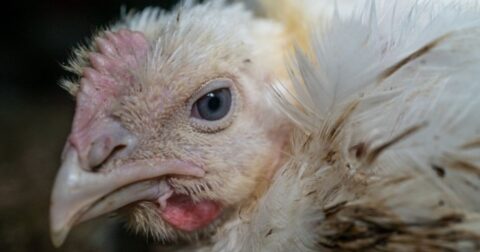Investigation
Homesteading Is a Viral Trend, but ‘Butchery Gone Awry’ Is Its Dark Side
Food•6 min read
Explainer
As America’s appetite for chicken increases, so too do the negative effects of poultry farms.


Words by Seth Millstein
Whether it’s scrambled eggs, chicken sandwiches or Thanksgiving turkey, Americans love their poultry. The average American eats around 115 pounds of poultry every year, compared with just 34 pounds in 1960, and chicken is now the most widely consumed meat in America. It’s probably no surprise, then, that the number of poultry farms in the United States has steadily increased during that time as well.
But this expansion comes at a great cost. Poultry farms are money-making enterprises that aim to produce as much food product as possible at the lowest cost. Animal welfare and environmental concerns take a backseat to profitability, and this prioritization has dreadful consequences for animals and the planet alike.
As of 2017, the most recent year for which data is available, there were 164,099 poultry farms in the U.S., according to the Department of Agriculture. That’s a 117 percent increase from 1992, when there were only 75,444 farms in the country.
This increase correlates with Americans’ rising appetite for chicken. But it’s not necessarily a positive development, as the poultry industry today inflicts massive harm on both animals and the environment (as we’ll get into in a minute).
Although the term “poultry” comprises many different birds, the overwhelming majority of the sector is chicken-based. In 2022, 87 percent of all poultry consumed by Americans was chicken, according to the National Chicken Council. American consumers spent $132 billion on chicken the next year year, and 381,164 American workers were directly employed by the chicken industry.
In the poultry industry, chickens are generally divided into two categories: broiler chickens, who are bred to become meat, and layer chickens, who are raised to lay eggs.
But poultry includes plenty of other fowl as well. Around 214 million turkeys are killed every year in slaughterhouses, along with 23 million ducks. Many of those ducks are raised to make foie gras, a grizzly process that involves force-feeding them with a tube for several weeks until they develop hepatic steatosis, also known as fatty liver disease — and then selling their engorged livers as a delicacy. A small number of guinea fowl are also raised for meat and eggs as well.
A 2019 report by the Sentience Institute found that over 99.9 percent of broiler chickens and 98.2 percent of egg-laying chickens are raised in factory farms. This isn’t ideal, as chickens on factory farms undergo near-constant suffering from the moments after their birth to the moment they’re slaughtered.
Newborn chicks have their beaks cut off, an acutely painful procedure that permanently mutilates them and sometimes renders them unable to drink. Around 300 million newborn male chicks are killed every year on poultry farms because they can’t produce eggs, and aren’t of the correct breed to become broilers. These chicks are typically killed either by being gassed or, in what must be one of the most gruesome methods of slaughter on any factory farm, ground up and shredded into pieces while they’re still alive.
Chickens that make it through this stage are then forced to live in cramped, confined spaces that prevent them from engaging in natural chicken behavior like preening and dust bathing. Broiler chickens are often packed together so tightly that they begin pecking one another (which is why their beaks are sliced off at birth), while layer chickens are confined to cages so small that they can’t spread their wings. Because of these cramped conditions, disease outbreaks are also common on poultry farms. In response, farmers often pump the birds full of antibiotics, a practice that’s helped create antibiotic-resistant bacteria that can infect humans as well.
Finally, chickens are shackled to a conveyor belt — a process that sometimes breaks their legs — then thrown into an electrified bath that’s meant to stun them. But it often fails to do so, in which case the chicken is conscious and unanesthetized as their throat is slit.
Wild and domesticated chickens can live to 10 years or more in their natural environments, but broiler chickens and layers are killed after around 40 days and 20 months, respectively.
Unfortunately, poultry farming is also bad for the environment in a number of ways.
For one, it creates massive amounts of waste in the form of feces, feathers, bedding and dead carcasses. This “poultry litter,” as it’s called, is not easy to store or dispose of, and often ends up polluting nearby waterways as a result. Chicken manure contains massive amounts of phosphorus and nitrogen, and when these substances end up in water, they can create harmful algae blooms that cause mass fish die-offs. Even more alarmingly, drinking water that’s contaminated with nitrates can give humans methemoglobinemia, a rare blood disorder that turns the skin blue and can be fatal for newborns.
Poultry farms also pollute the air. Chicken farms emit large amounts of ammonia and hydrogen sulfide, both of which are extremely foul-smelling and can cause intense eye and lung irritation to the humans who are exposed to it. And while manure in general is good for soil, the antibiotics and microorganisms in farmed poultry manure contaminate the soil, which in some cases can be enough to sicken or kill other local wildlife.
Finally, poultry farms require more resources than plant proteins like lentils or peas: a single 5-ounce chicken breast requires two pounds of CO2e emissions, nine square feet of habitat loss, 83 gallons of water and over half a pound of manure to create.
The many negative consequences of poultry farms naturally raises the question: What alternatives are there? If we were to eliminate poultry from our diets, what might we replace it with? It’s worth noting that chicken has loads of protein, and so any replacement would ideally be protein-rich as well.
Luckily, there are plenty of poultry replacements on the market that meet this standard. Impossible Foods, Beyond Meat and Meatless Farm all sell plant-based chicken alternatives with comparable levels of protein to a similar-size cut of chicken. Soybeans, peanut butter, lentils, seitan and tofu are also excellent sources of protein that don’t involve poultry farms.
Looking ahead a bit, lab-grown meat also has the potential to be a superb replacement for traditional poultry. Also known as cultivated meat, lab-grown meat is created by extracting a single stem cell from an animal — a chicken, for instance — and placing it in a specially formulated broth of nutrients. Over time, the cells grow and multiply, eventually forming muscle tissue that, despite its unconventional creation method, is biologically identical to traditional meat.
Unfortunately, lab-grown meat likely won’t be on store shelves for at least several years; it needs to overcome financial and logistical hurdles before it’s viable as a mainstream consumer product. But if and when that happens, it has the potential to be an excellent replacement for traditional poultry.
Despite how much harm its production causes, poultry remains immensely popular. But there are some signs, albeit small ones, that attitudes may be changing: The number of vegetarians in the U.S. has doubled over the last two decades, the plant-based chicken market is expanding more every year, and in 2023, lab-grown chicken meat was given FDA approval to be sold in stores for the first time.
In the absolute best-case scenario for animals and the environment, these trends will continue unabated, and poultry farming will eventually be a thing of the past. In a more realistic scenario, chicken consumption in the United States will continue to rise, barring breakthroughs with lab-grown meat. But shifting attitudes and technological advances could compel people to eat less poultry over time, which will lead to fewer poultry farms, less pollution and happier birds.